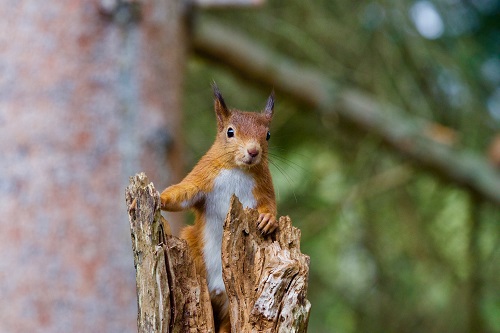Study by Inverness College UHI aims to address knowledge gaps around the impact of forest operations on red squirrels
A STUDY led by researchers at Inverness College UHI aims to address knowledge gaps around the impact of forest operations on red squirrels and the effectiveness of current mitigation measures.
Due to competition, disease and habitat loss, fewer than 120,000 red squirrels remain in Scotland.
The study led by Dr Louise de Raad, research fellow at Inverness College UHI, in partnership with Forest Enterprise Scotland, an agency of Forestry Commission Scotland, is looking at the impact of thinning operations on the protected species. This involved introducing artificial nest boxes in woodland near Inverness to observe red squirrel activity and drey usage during forest operations.
This has seen artificial nest boxes introduced in a woodland near Inverness to see if they can be used to alleviate any potential disturbance or natural drey loss caused by forest operations.
The red squirrel study has seen light-weight tracking equipment fitted to red squirrels to track their movements before and after forest operations. Preliminary results indicate that thinning operations during the breeding season have a very limited impact on the red squirrels. Females continued to breed successfully, while drey use and home ranges did not appear to change in response to forest operations.
Trail cameras attached to the nest boxes have captured tens of thousands of images, which show under what circumstances red squirrels used the boxes during forest operations. Now, as a first step in the team’s data analyses, volunteers are needed to help identify the photographs that contain red squirrels.
Members of the public can help by registering as a so-called “spotter” for the Highland Red Squirrel Project on www.mammalweb.org. Once registered, you can classify images and note what species, if any, you see on the images. MammalWeb is run by the Durham Wildlife Trust and the Department of Biosciences at Durham University, with the aim of improving the state of mammal monitoring in the UK and engaging the public.
Dr de Raad said: “This is an exciting opportunity for the public to get involved with scientific research and conservation and the best thing is that you can do it from home, even if you only have limited time available. Anybody who can recognise a squirrel is able to give invaluable support to our project that will allow us to find out more about how to best protect our remaining red squirrel populations.”
Forest Enterprise Scotland manages more than 400,000 hectares of Scotland’s woodland, and while Forestry Commission Scotland has developed detailed guidance on how to manage forests with red squirrels, the findings of this study will help improve the current guidance and enable better integration of timber production with red squirrel conservation.
The study is a joint research project between Inverness College UHI, Forest Enterprise Scotland (FES), Cairngorms National Park Authority (CNPA) and Scottish Natural Heritage (SNH) and is carried out in collaboration with Wageningen University (the Netherlands) and Durham University.
